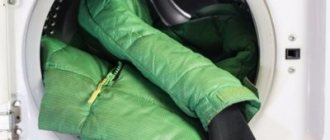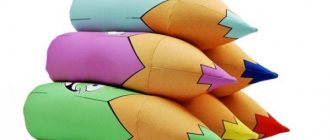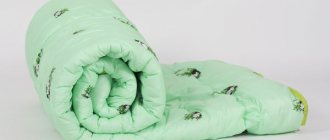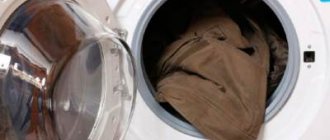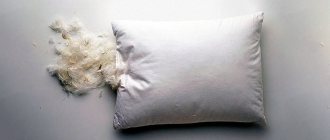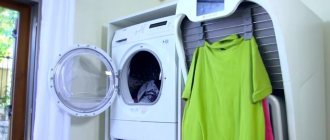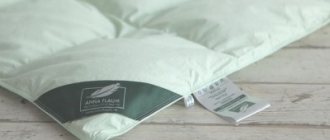Don't rush to make your bed immediately after waking up. Although they have been taught this way since childhood, many simply do not know what kind of life goes on on bed linen. Dust mites live on it, which can lead to an allergic reaction, inflammation of the respiratory tract, and asthma. Feather pillows (or other fillings) also need to be cleaned. A lot of microorganisms accumulate in it, and the rest of the epidermis collects.
Good pillows promote healthy sleep and good rest, so it is important to choose a comfortable product and keep it clean.
Washing pillows is not as difficult a job as many people think. For a positive result (so that the filler does not go astray), you need to follow several rules. Then the bed will always be fresh, and nothing will threaten your health.
To prevent your pillow from becoming a breeding ground for mold, dirt and dust mites, it must be washed periodically.
The first stage is to determine what the product consists of.
Washing will vary in ease of process depending on the contents inside. Thus, feather pillows are more difficult to process than modern silicone ones. The first stage of the procedure is to determine the type of filler (natural, artificial).
Many housewives believe that it is not necessary to wash pillows - it is enough to change the pillowcases.
Housewives often do not understand how to wash feather or synthetic padding pillows. But in reality, you will only need your own strength or a properly set mode in the washing machine.
Washing is not recommended for all products.
Feathers are not prohibited from being washed in a machine. The properties of this material should be clearly understood. In automatic mode, processing of both natural and artificial contents is allowed. Moreover, this is necessary after the first 6 months after use at a continuous pace. Ordinary drying under the sun will not give the desired result.
Pillows can be washed if the labels do not contain prohibiting symbols.
There are several exceptions: orthopedic type or analogues made from organic materials are not recommended for processing in an automatic machine.
Washing in a machine will save time and effort, allow you to better rinse out any remaining detergent, and speed up the drying process.
How to wash pillows filled with wool or bamboo
Unlike feather pillows, these pillows can be washed either whole or disassembled. If the size is large, then of course it would be better to disassemble it and wash the filling separately. If the size is small or medium, then it can be completely washed.
Features of washing bamboo pillows:
- You need to choose delicate or manual mode, otherwise there is a risk of damage to the product.
- It is also necessary to include an additional rinse. Without it, the filler will not wash well, and the remaining product will not be rinsed out.
- Use detergents for wool and cashmere items.
- It should be washed without spinning or set to a minimum of 500 revolutions. Then you need to let the remaining water drain.
During the drying period, you need to constantly knock down the filler. Thus, it will dry faster and will not deform.
Preparatory stage
When it becomes clear whether the pillows can be washed, you should move on to preparing them. It is aimed at obtaining the expected result. Down and feathers need an additional case. If you don’t want to buy it specifically for this job, then you should take an unnecessary pillowcase and stick the product into it (the free edge is secured with threads so that the contents do not come out).
Before washing, you need to carefully remove dust from the pillow.
If possible, it is better to divide the filler into several parts equal to each other. Each of them is put into bags and then placed in the washing machine. You need to pour it with caution, the fluff can scatter throughout the room, and it is difficult to collect it. At the end of washing, all parts are combined. This approach will help to better process and dry the raw materials.
When choosing a detergent, you should give preference to gel.
Although washing pillows is the main process, dust is always knocked out of the product before it. Of course, you can put dirty material into the washing machine, but then the dust will not go anywhere, and stains will appear on the cover (removing them takes a lot of time, effort, and sometimes is not at all realistic).
It is worth choosing a product without a bleaching effect, otherwise stains may remain on the case.
By hand or in a machine
When filled with organic type, the pillow can be washed in the washing machine. But organic matter does not have a long service life, so everyone must decide for themselves whether it is advisable to clean out old raw materials if they can purchase a new product.
You can contact a professional service, where the pen undergoes thorough processing.
Here is the sequence of how to wash pillows in a washing machine correctly.
- The original pillowcase is opened to remove the insides.
- The fluff is placed in different bags (about 3-5 parts).
- The water temperature is a maximum of thirty degrees (organic matter is washed in cold water, since hot liquid has a negative effect on it).
- Mode selection. Each device has its own designation, so you should choose a delicate one, for example, manual or swan-down mode.
- It may seem that it is better to use the maximum spin speed, but this is not so. Here you need slow drying, so four hundred turns will do. Sometimes it is worth not using this function at all.
The choice of washing and spinning modes will depend on the filler of the product.
An important criterion is the choice of detergent. The usual powder is not suitable for this purpose. On store shelves you can find a special composition, the purpose of which is to clean down and feathers. If this cannot be found, then take a gel, liquid powder or a composition in the form of a detergent with ammonia no more than three percent (approximate calculation: for five liters you should take a cap of soap and four teaspoons of ammonia).
If you wash it incorrectly, you can get the opposite result instead of a neat “fluffy” pillow.
If necessary, you can wash the product by hand. On the contrary, fluff in such a cleansing will look better, due to the inability to bunch up. A few basic rules when choosing manual processing.
- Take water at room temperature (not hotter than thirty degrees).
- Choosing a container - the best solution would be the bathroom. Filling is poured into it after the pillowcase has been opened.
- Soaking is allowed from three to four hours. You shouldn't do this any longer.
- After a predetermined period of time, the contents of the bathtub begin to be removed. It is better to do this using a colander.
- Having given away the feathers, they are packaged in separate bags.
- The resulting number of bags is hung on the street, where they begin to dry.
Not only feather pillows, but also anti-stress options or bamboo filling are treated using this method.
The feathers are removed from the pillow and washed separately.
Holofiber is washed by hand. It is better to take a gel-like detergent, add it to a lukewarm liquid, and soak the pillow in this composition (no longer than one hundred and twenty minutes). Push up without force, with light movements. Afterwards, rinse again in clean, lukewarm water. Only now it’s time to hang it out to dry.
It is better to do this outside, the main thing is not to expose it to direct sunlight.
Sintepon versions of the product are cleaned according to the same scheme as holofiber.
Bamboo bedding is not processed in hot liquid (about thirty degrees). Ordinary laundry soap is suitable as a detergent. All highly foaming products are not suitable for high-quality processing. Finally, the pillow is rinsed in liquid at room temperature.
To dry, it is better to place the item on a horizontal surface.
Period of use and washing
Depending on the material of production, the product is allocated an approximate number of times for processing. Here are all the types of possible filler and their dependence in relation to washing.
- Synthetics - constant washing reduces the service life as much as possible, so it is better to replace it with a new product.
- Feather or down - processed no more than four times in twelve months, but there should be a minimum of two processes.
- Bamboo is durable and can withstand more than six washes per year. Ticks do not like such products.
- Anti-stress - it is recommended to clean more than five times in twelve months.
Synthetic filling made of polyester and holofiber should be washed at least 3-4 times a year.
Now that the washing process is outlined point by point, you should understand proper drying.
Varieties
The rules for washing pillows depend on what filler they contain. You can find out if you open the seam a little and look inside.
If the sewn-on label has been preserved, it contains detailed information about the composition of the filler.
The following main groups can be distinguished:
- feathers;
- synthetic;
- with organic filler;
- orthopedic.
Natural down is a high-quality and popular filler. These pillows keep you cool in the summer and warm in the winter. The feathers softly spring and easily return to shape, air is retained between them, and the pillow “breathes.” On the other hand, down products become denser over time and no longer properly support the head. They absorb moisture and therefore require daily drying. The cost of a high-quality down-feather mixture is quite high.
Nowadays feathers are increasingly being replaced by synthetics. Artificial materials have many useful properties, they:
- easy to care for;
- cheap;
- hypoallergenic.
Thin white fibers do not absorb odors and retain heat well.
But padding polyester pillows lose their elasticity relatively quickly. To eliminate this drawback, polyester fibers are twisted into balls and treated with silicone. The material consisting of such balls is called holofiber. It holds its shape better, which can be easily restored by shaking the pillow well.
Pillows with natural fillings and orthopedic ones have a healing effect during sleep. The variety of materials for them is very large, both in terms of their effect on the body, and in type and quality. Most of them cannot be washed. But if you are still ready to take a risk, carefully study the composition and properties of the materials. If possible, limit yourself to surface cleaning.
The final stage is drying the contents
It became clear whether a pillow made of feathers, bamboo or organics can be washed. Time to move on to drying the fillers, which will not lead to negative consequences.
Experts do not recommend using a washing machine or a special dryer.
Basic tips for this stage.
- The process is faster outside.
- When drying indoors, there must be good ventilation (artificial, natural).
- In order to speed up the process, many try to use additional heat, but this should not be done.
- Placing the bags in the open sun or under an open heat source is prohibited. This intensity spoils the filler.
- During drying, it is necessary to constantly turn the bags over.
It is best to carry out the procedure outdoors or indoors with good natural or artificial ventilation.
Not everyone wants to suffer with the last stage, so they use a high spin value. This approach will not lead to anything other than the acquisition of a new product, since the old analogue will be completely knocked down into one layer, which cannot be broken.
It is better to dry pillows outdoors.
To ensure this result, tennis balls (2-3 pieces) are placed inside the drum before washing. They will fluff up the feathers, making it impossible for them to clump into one mass.
It can be helpful to throw a few tennis balls into the washing machine drum. They will not allow the filler to clump together.
Cleaning the washing machine from harmful “waste”
It happens that as a result of washing in an automatic machine, the pillow cover rips open or holes form in it. The filler falls out of them and clogs the filter, which in the future can lead to serious damage to the unit.
If this happens, you need to immediately turn off the automatic machine, drain the water and open the door. Then you need to thoroughly clean the feathers, balls or other filler from the drum and clean the drain filter. After this, it is recommended to carry out a quick wash without laundry and repeat the cleaning.
Latex pillows
This version of the product is only suitable for manual cleaning. In this case, the total amount should be minimal, and the temperature should be from thirty to forty degrees Celsius. You need to rinse in lukewarm, cool water. Spin - wrap in a towel. It will absorb excess moisture.
Brute force will only damage integrity.
Latex is a fragile material and should not be subjected to frequent wet processing. If possible, the surface can be cleaned using steam. This is an alternative to conventional washing.
Steaming will kill all harmful bacteria and make the bedding fresher.
To implement it, you will need to perform the following actions.
- The pillow should hang in a vertical position.
- Primary steam treatment.
- Repeated.
- Leave to dry.
- After complete drying, the bedding is fluffed.
- An additional pillowcase is put on at the end.
Such products can be washed 5-7 times a year, but very carefully.
Helpful tips to extend the life of your bedding
- Change your pillowcase at least once a week to reduce the chance of contamination.
- Make your bed to protect it from dust and dirt. But not immediately after waking up: it is better to leave the bed for 20-30 minutes so that the remaining moisture from the body evaporates.
- The pillow should be stored in a dry cabinet with closed doors. It is better if the product is packaged in a special package.
- Be sure to use a protective cover, even if you change bedding very often. An "outer" pillowcase can not only prevent stains or dirt from appearing, but also make your sleep more comfortable thanks to the extra layer of filling.
- Follow the service life stated by the manufacturer. If they pass and you notice that you are sleeping worse, change your pillow.
- Don't limit yourself to just one product: choose a couple of options - for example, an anatomical model with cooling gel for the summer season and with a memory effect for the cold season.
Care Tips
It became clear whether pillows can be washed manually or in an automatic machine. But to prolong their service life, it is worth taking proper care of the pillows.
It is important to completely dry the pillows, otherwise in the future their “insides” will begin to rot, emitting an unpleasant odor.
There are several useful tips to help with care.
- Whisk regularly.
- Clean constantly.
- Keep pets away.
- If there are dents or an unpleasant smell, try to restore it, buy a new one.
If you wash and dry your pillow correctly, it will look like new and will be a pleasure to sleep on.
Regular care of bedding is the key to health and good sleep.
How to dry properly
It is equally important to properly dry the filler. Otherwise, poorly dried pillows may acquire an unpleasant odor due to the onset of rotting or mold. In preventing such an unpleasant prospect, the sun and fresh air will come to our aid where we need to place the washed product.
We hang the feather pillow by the corner and turn it over every couple of hours. It is recommended to dry holofiber pillows by laying them horizontally. We also turn them over from time to time, and the filling should be thoroughly beaten. The duration of drying is determined by the size of the product and the filler; it is better to take your time to achieve quality.


